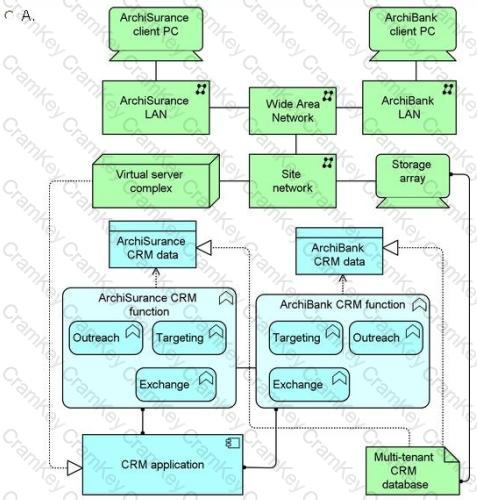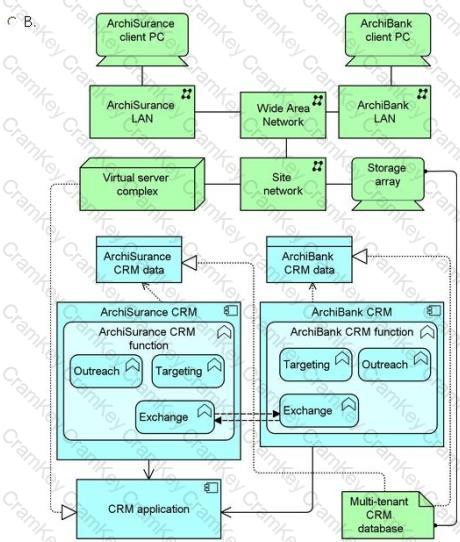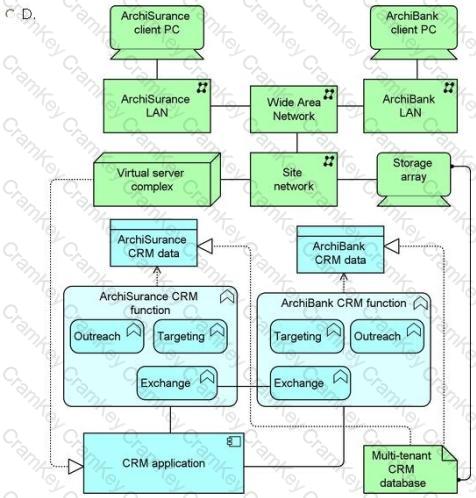| Exam Name: | ArchiMate 2 Combined Part 1 and 2 Examination | ||
| Exam Code: | OG0-023 Dumps | ||
| Vendor: | The Open Group | Certification: | ArchiMate 2 Certified |
| Questions: | 103 Q&A's | Shared By: | cillian |
The ArchiMate modeling language can be used to describe different types of architecture and the relationships between them.
Which of the following lists the three main layers of the ArchiMate language?
Scenario
Please read this scenario prior to answering the question
The ArchiSurance enterprise document management infrastructure provides critical support for myriad types of documents and document-based transactions, many of which are executed in high volume each day. At the core of the infrastructure is the document management systems software, which has three major modules: a document engine that stores, retrieves and performs a variety of operations on documents, a workflow engine that hosts document management applications, and an application engine, which hosts the most sophisticated applications. The application engine invokes the document and workflow engines as necessary when hosting application components that require their services.
The claim management application component is critical to ArchiSurance business operations. It is hosted by the application engine, and launches whenever an individual files a new claim. The claim management component requires different documents to demonstrate proof of loss depending on the type of claim filed, the type of insurance that is in force, and various other circumstances. When the correct documents are filed and verified by an intake operator, proof of loss is complete, and the claim management component assigns the claim to a claim analyst by reading and updating analyst status data and applying business rules stored as data.
Due to its business-critical nature, the document management solution is hosted redundantly at two geographically separate data center sites known as Site A and Site B. Both sites provide identical infrastructure. Each site contains a highly available data center network (DCN) that is connected to the highly available ArchiSurance wide area network (WAN). Each claim management server is connected to its site DCN, and each DCN is a converged network that connects both servers and storage arrays, including a physical storage array dedicated to the claim management application. Each site contains four high-powered separate physical serversrules stored as data.
Due to its business-critical nature, the document management solution is hosted redundantly at two geographically separate data center sites known as Site A and Site B. Both sites provide identical infrastructure. Each site contains a highly available data center network (DCN) that is connected to the highly available ArchiSurance wide area network (WAN). Each claim management server is connected to its site DCN, and each DCN is a converged network that connects both servers and storage arrays, including a physical storage array dedicated to the claim management application. Each site contains four high-powered separate physical servers dedicated to the claim management application. At any one time, one server is on standby while the other three servers are, respectively, hosting the document, workflow and application engines. Each active server provides a monitoring service that is In constant two-way communication with the monitoring service on the standby server. If a server fails, the surviving monitoring services perform a failover sequence to assume failed server's workload if it was active. The surviving monitoring services also alert the operations team on duty.
Refer to the Scenario
A new IT manager has asked you to model the infrastructure hardware and networks that supports document management, including the data center sites, servers, storage, and networks as well as the services necessary for automated failover within a server cluster. Since the two data centers provide identical document management infrastructure, for Site B it is only necessary to show the associated networking.
Which is the best answer?




Scenario
Please read this scenario prior to answering the question
ArchiSurance has a partnership with ArchiBank in which the two companies market each other's consumer offerings to their own customers. Each quarter, the chief marketing officers (CMOs) of the two companies work together to plan the next quarter's promotions. First, they review each other's business objectives related to the partnership. Then, they formulate the co-operative marketing plan. The CMOs determine which offerings they will promote, the characteristics of the target customers, and the timing of each promotion. They assemble their findings into a co-operative marketing plan that Is reviewed separately by the chief financial officer (CFO) of each organization. If either of the CFOs finds a problem, the CMOs must quickly work together to formulate another version of the plan. The review and reformulation process continues until both CFOs have approved a version of the plan. Then,the CMOs share the plans with their respective operations teams. Each organization's operations team configures the bank's systems toexecute the joint promotions.
The cooperative marketing process is enabled by CRM software delivered as a service (SaaS). The two organizations each use separate logical instances of a multi-tenant customer relationship management (CRM) application hosted by a service provider. Each company's CRM instance is a dedicated function of the same CRM application component. The dedicated functions also share the same multi-tenant database. The component's data access layer is designed with safeguards to keep each company's data separate unless it is intentionally shared.
Each CRM instance has targeting, exchange and outreach sub-functions. The targeting sub-functions select customers based on criteria developed by the CMOs and configured by the operations teams. The exchange sub-functions share the selected customer profiles with each other, and the outreach sub-functions generate promotional email. In this way, each company's CRM system generates a list of target customers that the other company's CRM system uses to send promotional email.
The multi-tenant CRM application component is hosted on a large virtual server complex that is connected via a site network to a physical storage array and a commercial wide-area network (WAN) used by both companies. Both companies access their CRM systems via PCs connected to Local Area Networks (LANs) that are in turn connected to the shared commercial WAN.
Refer to the Scenario
The new head of IT has asked you to describe how the CRM application supports the partnership, including the CRM application itself, the various application functions and the data flows between them, and the hosting and networking that supports the CRM application.
Which answer provides the best description?




Scenario
Please read this scenario prior to answering the Question
ArchiSurance has a partnership with ArchiBank in which the two companies market each other's consumer offerings to their own customers. Each quarter, the chief marketing officers (CMOs) of the two companies work together to plan the next quarter's promotions. First, they review each other's business objectives related to the partnership. Then, they formulate the co-operative marketing plan. The CMOs determine which offerings they will promote, the characteristics of the target customers, and the timing of each promotion. They assemble their findings into a co-operative marketing plan that is reviewed separately by the chief financial officer (CFO) of each organization. If either of the CFOs finds a problem, the CMOs must quickly work together to formulate another version of the plan. The review and reformulation process continues until both CFOs have approved a version of the plan. Then, the CMOs share the plans with their respective operations teams. Each organization's operations team configures the bank's systems to execute the joint promotions.
The cooperative marketing process is enabled by CRM software delivered as a service (SaaS). The two organizations each use separate logical instances of a multi-tenant customer relationship management (CRM) application hosted by a service provider. Each company's CRM instance is a dedicated function of the same CRM application component. The dedicated functions also share the same multi-tenant database. The component's data access layer is designed with safeguards to keep each company's data separate unless it is intentionally shared.
Each CRM instance has targeting, exchange and outreach sub-functions. The targeting sub-functions select customers based on criteria developed by the CMOs and configured by the operations teams. The exchange sub-functions share the selected customer profiles with each other, and the outreach sub-functions generate promotional email. In this way, each company's CRM system generates a list of target customers that the other company's CRM system uses to send promotional email.
The multi-tenant CRM application component is hosted on a large virtual server complex that is connected via a site network to a physical storage array and a commercial wide-area network (WAN) used by both companies. Both companies access their CRM systems via PCs connected to Local Area Networks (LANs) that are in turn connected to the shared commercial WAN.
Refer to the Scenario
In preparation for a presentation to investors, the ArchiSurance chief financial officer has asked you to model the business architecture of the partnership, including the executives and teams involved, the information they exchange, and the activities they perform.
Which answer best describes this business architecture?



